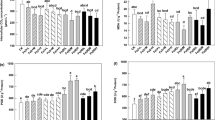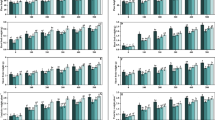Abstract
Background and Aims
Management options to reduce the negative impacts of iron (Fe2+) toxicity in lowland rice (Oryza sativa L.) are limited. Improving productivity and ensuring sustainability of such systems requires a sound ecophysiological understanding of this widespread problem.
Methods
The effectiveness of dolomite [CaMg (CO3)2] application to increase the availability of soil phosphorus (P) to rice plants, and to decrease the bioavailability of Fe2+ was tested at two locations, one with and one without effects of Fe2+ toxicity. We used a Fe2+-susceptible and a Fe2+-tolerant rice variety, with and without the application of dolomite at a rate of 1 t ha−1for three consecutive seasons. In a pot experiment, we studied the shoot and root growth, and soil and plant P and Fe nutrition with the application of 0, 1 and 10 t ha−1 of dolomite in an iron-toxicity affected soil.
Key Results
With the application of dolomite, both in the field and in the pot experiment, the exchangeable soil Fe2+ concentration decreased with an increase in soil pH and P availability. Plant height, shoot and root dry weight, grain yield, and P and potassium content increased, whereas the organ Fe concentration and content decreased with a greater response by the Fe2+-susceptible rice variety than by the tolerant variety, and with the greatest effect at the Fe2+-toxicity-affected site.
Conclusion
Application of dolomite to lowland rice fields affected by Fe2+ toxicity can increase grain yield, while reducing the negative impacts of Fe2+ toxicity. The magnitude of these positive responses would vary depending on variety, season and soil conditions.







Similar content being viewed by others
References
Adams F, Burmester C, Hue NV, Long FL (1980) A comparison of column-displacement and centrifuge methods for obtaining soil solutions. Soil Sci Soc Am J 44:733–735
Allen RJL (1940) The estimation of phosphorus. Biochem J 34:858
Barber SA (1995) Soil Nutrient Bioavailability: A Mechanistic Approach, 2nd edn. John Wiley, New York
Becker M, Asch F (2005) Iron toxicity in rice- conditions and management concepts. J Plant Nutr Soil Sci 168:558–573
Benckiser G, Ottow JCG, Santiago S, Watanabe I (1983) Iron toxicity – Effect of phosphorus, potassium, calcium and magnesium fertilization on rhizoflora, redox potential and iron uptake by different rice varieties (Oryza sativa L.). Landwirtsch Forsch 36:285–299
Benckiser G, Santiago S, Neue HU, Watanabe I, Ottow JCG (1984) Effect of fertilization on exudation, dehydrogenase activity, iron-reducing populations and Fe ++ formation in the rhizosphere of rice (Oryza sativa L.) in relation to iron toxicity. Plant Soil 79:305–316
Dobermann A, Fairhurst TH (2000) Rice: Nutrient Disorders and Nutrient Management. IRRI, Philippines
Dramé KN, Saito K, Koné B, Chabi A, Dakouo D, Annan-Afful E, Monh S, Abo E, Sié M (2010) Coping with iron toxicity in the lowlands of sub-Saharan Africa: Experience from Africa Rice Center. In: Innovation and Partnerships to Realize Africa’s Rice Potential, Second Africa Rice Congress. Bamako, Mali, pp. 22–26
Fageria NK (1988) Influence of iron on nutrient uptake by rice. International Rice Res Newslett 13:20–21
Fageria NK, Rabelo NA (1987) Tolerance of rice cultivars to iron toxicity. J Plant Nutr 10:653–661
Gregorio GB, Senadhira D, Htut H, Graham RD (2000) Breeding for trace mineral density in rice. Food Nutr Bull 21:382–386
Jugsujinda A, Patrick WH Jr (1993) Evaluation of toxic conditions associated with oranging symptoms of rice in a flooded Oxisol in Sumatra, Indonesia. Plant Soil 152:237–243
Kitson RE, Melon MG (1944) Colorimetric determination of phosphorus as molybdo vanado phosphoric acid. Ind Eng Chem 16:379
Neue HU, Quijano C, Senadhira D, Setter T (1998) Strategies for dealing with micronutrient disorders and salinity in lowland rice systems. Field Crops Res 56:139–155
Olsen S, Cole C, Watanabe F, Dean L (1954) Estimation of Available Phosphorus In Soils by Extraction with Sodium Bicarbonate. USDA Circular Nr 939. US Gov. Print. Office, Washington, DC
Ottow JCG, Prade K, Bertenbreiter W, Jacq VA (1993) Iron toxicity mechanisms of flooded rice (Oryza sativa L.) in Senegal and Indonesia. Bas-Fonds, et Riziculture., Ed. M. Raunet, pp. 231–241, CIRAD-CA, Montpellier
Ponnamperuma FN (1972) The chemistry of submerged soils. Adv Agron 24:29–96
Ponnamperuma FN, Bradfield JF, Peech M (1955) Physiological diseaseof rice attributable to iron toxicity. Nature 175:275
Prade K (1987) Einfluß der Nährstoffversorgung auf die Eisentoxizität bei Naßreis (Oryza sativa L.) in der Basse Casemance/ Senegal. Ph.D. Thesis, University of Gießen, Germany
Ramírez LM, Claassen N, Ubiera AA, Werner H, Moawad AM (2002) Effect of phosphorus, potassium and zinc fertilizers on iron toxicity in wetland rice (Oryza sativa L.). Plant Soil 239:197–206
Römheld V (1991) The role of phytosiderophores in acquisition of iron and other micronutrients in graminaceous species: An ecological approach. Plant Soil 130:127–134
Sahrawat KL (2000) Elemental composition of the rice plant as affected by iron toxicity under field conditions. Commun Soil Sci Plant Anal 31:2819–2827
Sahrawat KL, Mulbah CK, Diatta S, Delaune RD, Patrick WH Jr, Singh BN, Jones MP (1996) The role of tolerant genotypes and plant nutrients in the management of iron toxicity in lowland rice. J Agric Sci 126:143–149
SAS (2005) Statistical Analysis Systems, release 9. SAS Institute Inc., Cary, NC, USA
Savithri S, Perumal R, Nagarajan R (1998) Soil and crop management technologies for enhancing rice production under micronutrient constraints. Nutr Cycl Agroecosys 53:83–92
Somaweera KATN, Suriyagoda LDB, Sirisena DN, De Costa WAJM (2015) Accumulation and partitioning of biomass, nitrogen, phosphorus and potassium among different tissues during the life cycle of rice grown under different water management regimes. Plant Soil 401:169–183
Suriyagoda L, De Costa WAJM, Lambers H (2014) Growth and phosphorus nutrition of rice when inorganic fertiliser application is partly replaced by straw under varying moisture availability in sandy and clay soils. Plant Soil 384:53–68
Suriyagoda LDB, Tibbett M, Edmonds-Tibbett T, Cawthray GR, Ryan MH (2016) Poor regulation of phosphorus uptake and rhizosphere carboxylates in three phosphorus-hyperaccumulating species of Ptilotus. Plant Soil. doi:10.1007/s11104-015-2784-y
Takijima Y, Wijayaratna HMS, Seneviratne CJ (1970) Nutrient deficiency and physiological disease of lowland rice in Ceylon. Soil Sci Plant Nutr 16:11–16
Tanaka A, Loem R, Navasero SA (1966) Some mechanisms involved in the development of iron toxicity symptoms in the rice plant. Soil Sci Plant Nutr 12:158–164
Van Ranst E, Verloo M, Demeyer A, Pauwels JM (1999) Manual for the soil chemistry and fertility laboratory-analytical methods for soils and plants, equipment, and management of consumables. University of Gent, Gent, Belgium
Walkley A, Black IA (1934) Estimation of soil organic carbon by the chromic acid titration method. Soil Sci 37:29–38
Wijewardena JDH (2005) Improvement of plant nutrient management for better farmer livelihood, food security and environment in Sri Lanka. In: Improving Plant Nutrient Management for Better Farmer Livelihoods, Food Security and Environmental Sustainability. Proceedings of a Regional Workshop, FAO, Regional Office for Asia and the Pacific.
Wissuwa M, Gamat G, Ismail AM (2005) Is root growth under phosphorus deficiency affected by source or sink limitations? J Exp Bot 56:1943–1950
Acknowledgments
We thank G. Wijesuriya and WMN Wanninayake for technical assistance. This study was supported by grant number C/5140-1 from the International Foundation for Science, Sweden in 2011.
Author information
Authors and Affiliations
Corresponding author
Additional information
Responsible Editor: Tim S. George.
Rights and permissions
About this article
Cite this article
Suriyagoda, L., Sirisena, D., Somaweera, K. et al. Incorporation of dolomite reduces iron toxicity, enhances growth and yield, and improves phosphorus and potassium nutrition in lowland rice (Oryza sativa L). Plant Soil 410, 299–312 (2017). https://doi.org/10.1007/s11104-016-3012-0
Received:
Accepted:
Published:
Issue Date:
DOI: https://doi.org/10.1007/s11104-016-3012-0




